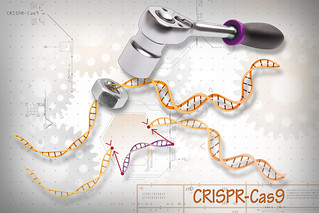A pinch of salt for CRISPR research

Unless you’ve been sitting in a cave for the last couple of years, you have probably heard about the new great promise of gene therapy: the gene editing CRISPR system. This new addition to the molecular biology toolbox is groundbreaking for what it implies. It does not simply “force in” a healthy copy of whichever mutated version of a gene, but operates over the “sick” copy of the gen in the cell by cutting and replacing the mutated nucleotides for the “healthy” ones. One of the big advantages of this method is that it avoids integration of extraneous DNA in regions away from the mutation, and there decreasing the chances of inducing tumoral processes.
Even though there are reports on using this technology in animal research of liver disease and muscular dystrophy, and there is even a recent publication on using CRISPR to code image and movie data into a bacterial genome, it is still soon to claim that CRISPR will be the hero of the century, and be able to eradicate most genetic diseases. Why?

One reason is that the CRISPR genetic scissors (Cas9) might not only be restricted to cutting the DNA in the region to repair but keep on indiscriminately cutting the genome, potentially leading to cancer. Several strategies are being put in place to increase the specificity of the CRISPR cuts, and to ideally inactivate the Cas9 enzyme once it has performed its duty. However, we are not there yet.
On the other hand, it is easier to cut out the problematic part of a gene than forcing the cell to repair this cut with the supplied healthy DNA strand, mostly because for this process (homology-directed repair) to be efficient cells have to be actively dividing, and many cells in the body, like neurons or muscle cells, do not divide so often. A solution for this problem could be to activate the necessary homology-directed repair mechanisms without inducing cell division.
Another issue yet to solve is delivery, since the genetic editing should ideally occur in the patient’s body. How to effectively deliver the CRISPR system to the affected cells without compromising the rest of the cells and organs of the patient is still not clear. So far, viral vectors have been the choice for gene therapy but this strategy has inherent problems like the packing size of the viral particles and the potential for expansion of the CRISPR system to unaffected cells in the body.
In conclusion, even though this new technology offers renewed hope for gene therapy, since it extends the range of diseases susceptible of being treated, it is still not to expect therapeutic effects in humans any time soon.
1 comment
[…] CRISPR es una palabra de modo por lo revolucionaria que es la técnica Cas9 basada en ella. Ahora bien, puede que no todo sea tan simple. Rosa García-Verdugo en A pinch of salt for CRISPR research […]